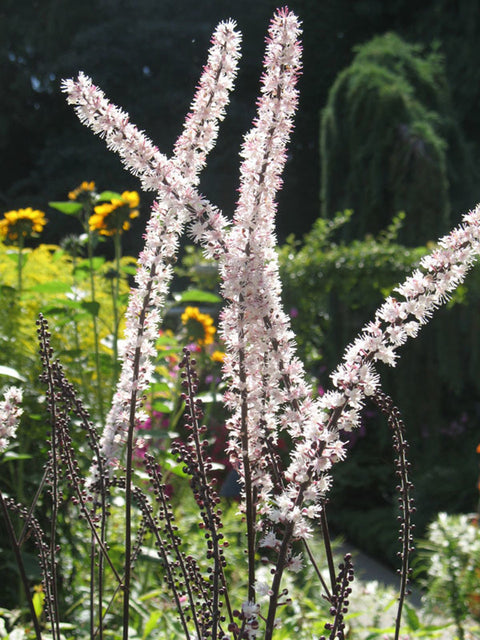About Black Cohosh
Black Cohosh (Actaea racemosa), also known as Black Snakeroot or Fairy Candle, is a native perennial that’s as beautiful as it is useful in the garden. It’s a species native to the rich woods of eastern North America and has been used medicinally for generations. In the garden, this plant stands out for its tall, dramatic flower spikes that bloom in mid-to-late summer. Black Cohosh is ideal for shady borders, woodland gardens, and naturalized settings. It does well in partial to full shade and, as an added bonus, is deer resistant. Here’s a closer look at how this striking native can enhance your shady spots.
Summertime Brilliance: Black Cohosh is known for its unique and showy flowering display.
In late June through August, four- to six-foot-tall stems shoot up well above the foliage and are topped by long, tapering racemes of tiny white flowers. They resemble a row of tall candles when in full bloom, and the effect is particularly striking when they’re backlit by dappled sunlight streaming through the trees. These flowers have a subtle fragrance, sometimes described as slightly sweet with earthy undertones, and they attract a range of pollinators like bees, flies, and beetles. The tall flower spikes add vertical interest and drama to shaded areas of the garden.
Lush Foliage: In addition to its impressive blooms, Black Cohosh has handsome, large, compound leaves with deeply serrated leaflets that form a lush, dark green mound. This mound provides nice texture and a bold contrast for other woodland wildflowers you might mix it with, like ferns, hostas, and astilbes. Even when the plant isn’t in bloom, it offers a dense, attractive foliage that enriches the shady landscape.
Pollinator Friendly: Black Cohosh can be a good choice for supporting pollinator diversity.
Its summer blooms provide important nectar and pollen sources when many spring ephemerals have already gone by. Additionally, it serves as a host plant for some native moth species, making it a valuable addition to a healthy woodland garden.
Maintenance and Growth: Gardeners love Black Cohosh not only for its ornamental value but also because it’s relatively low-maintenance. It’s long-lived and once established, will reliably return each year with minimal care. It prefers humus-rich, consistently moist soil, but it can adapt to average garden soil as long as it isn’t allowed to dry out. This is a mid-to-late summer bloomer, which helps bridge the gap between early spring woodland flowers and late-season foliage plants.
Historical Context: Worth noting is the plant’s history of medicinal use by Indigenous peoples of North America and subsequent herbalists. It was particularly noted in traditional women’s health remedies. However, in the garden today, it is primarily grown for its ornamental qualities and not for its medicinal uses.
In Summary, With its tall stature and showy flowers, Black Cohosh is a natural focal point in shade gardens. It contrasts beautifully with darker greenery and the airy elegance of its white flowers provides a lovely, ethereal touch to shady spots in your yard. Whether used as a specimen plant or mixed with other woodland natives, it’s a true winner for gardeners who love plants that have both ornamental impact and wildlife value.



